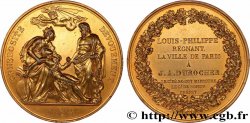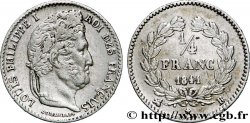fme_973283 - LOUIS-PHILIPPE I Médaille pour la mort de Ferdinand Philippe, Duc d’Orléans
70.00 €(Approx. 74.20$ | 58.10£)
Quantity
Add to your cart

Type : Médaille pour la mort de Ferdinand Philippe, Duc d’Orléans
Date: 1842
Mint name / Town : 92 - Neuilly
Metal : tin
Diameter : 32,5 mm
Orientation dies : 12 h.
Weight : 6,23 g.
Edge : lisse
Puncheon : sans poinçon
Coments on the condition:
Flan voilé. Présence de coups et rayures. Restes de brillant de frappe à l’avers
Obverse
Obverse legend : S. A. R. F.ND L.IS C.LES H.RI DUC D’ORLEANS..
Obverse description : Tête du duc d’Orléans à droite, palme et branche de laurier sous le buste.
Reverse
Reverse legend : À L’EXERGUE : MORT DU PRINCE ROYAL / 13 JUILLET / 1842.
Reverse description : Scène où le prince est allongé sur un lit, entouré par les siens (en pleurs). Décoration de l’intérieur d’une pièce en arrière plan.
Commentary
Ferdinand Philippe Louis Charles Éric Rosalino d'Orléans, né le 3 septembre 1810 à Palerme et mort le 13 juillet 1842 à Neuilly-sur-Seine, duc de Chartres puis (1830) duc d’Orléans et prince royal de France, est le fils aîné de Louis-Philippe Ier, roi des Français et de Marie Amélie de Bourbon, princesse des Deux-Siciles.
En 1831, le duc d’Orléans part avec son jeune frère le duc de Nemours, pour aller faire ses premières armes sous les ordres du maréchal Gérard ; cette campagne ne fut guère qu’une promenade militaire. Entrés en Belgique en 1831, les princes s’empressent de visiter la plaine de Jemappes, où leur père a combattu en 1792.
L’année suivante, le duc d’Orléans rentre en Belgique avec le commandement de la brigade d’avant-garde de l'armée du Nord. Le 20 novembre 1832, il est devant la citadelle d'Anvers ; il commande la tranchée dans la nuit du 29 au 30 novembre. À l’attaque meurtrière de la lunette Saint-Laurent, il s'élance sur le parapet au milieu d’une grêle de projectiles de toute espèce pour diriger l’action et stimuler le courage des soldats.
En 1835, lorsque le maréchal Clauzel est renvoyé en Algérie comme gouverneur général, le duc d’Orléans demande à son père comme une faveur de l'accompagner pour combattre l’émir Abd El-Kader. Il participe avec l’armée de Clauzel à la bataille de l'Habrah, où il est blessé, à la prise de Mascara en décembre 1835, puis de Tlemcen en janvier 1836. Il rentre à Paris tout auréolé de gloire militaire..
En 1831, le duc d’Orléans part avec son jeune frère le duc de Nemours, pour aller faire ses premières armes sous les ordres du maréchal Gérard ; cette campagne ne fut guère qu’une promenade militaire. Entrés en Belgique en 1831, les princes s’empressent de visiter la plaine de Jemappes, où leur père a combattu en 1792.
L’année suivante, le duc d’Orléans rentre en Belgique avec le commandement de la brigade d’avant-garde de l'armée du Nord. Le 20 novembre 1832, il est devant la citadelle d'Anvers ; il commande la tranchée dans la nuit du 29 au 30 novembre. À l’attaque meurtrière de la lunette Saint-Laurent, il s'élance sur le parapet au milieu d’une grêle de projectiles de toute espèce pour diriger l’action et stimuler le courage des soldats.
En 1835, lorsque le maréchal Clauzel est renvoyé en Algérie comme gouverneur général, le duc d’Orléans demande à son père comme une faveur de l'accompagner pour combattre l’émir Abd El-Kader. Il participe avec l’armée de Clauzel à la bataille de l'Habrah, où il est blessé, à la prise de Mascara en décembre 1835, puis de Tlemcen en janvier 1836. Il rentre à Paris tout auréolé de gloire militaire..








 Report a mistake
Report a mistake Print the page
Print the page Share my selection
Share my selection Ask a question
Ask a question Consign / sell
Consign / sell
 Full data
Full data










